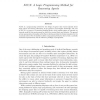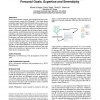1640 search results - page 81 / 328 » Design of Synchronous Action Systems |
ICCD
1992
IEEE
13 years 11 months ago
1992
IEEE
Asynchronous or self-timed systems that do not rely on a global clock to keep system components synchronized can offer significant advantages over traditional clocked circuits in ...
CORR
2004
Springer
13 years 7 months ago
2004
Springer
FLUX is a programming method for the design of agents that reason logically about their actions and sensor information in the presence of incomplete knowledge. The core of FLUX is...
DATE
2010
IEEE
14 years 24 days ago
2010
IEEE
Abstract—Media processing systems often have limited resources and strict performance requirements. An implementation must meet those design constraints while minimizing resource...
CHI
2009
ACM
14 years 2 months ago
2009
ACM
How is work created, assigned, and completed on large-scale, crowd-powered systems like Wikipedia? And what design principles might enable these federated online systems to be mor...
DATE
2006
IEEE
14 years 1 months ago
2006
IEEE
With the increasing complexity and heterogeneity of embedded electronic systems, a unified design methodology at evels of abstraction becomes a necessity. Meanwhile, it is also i...


